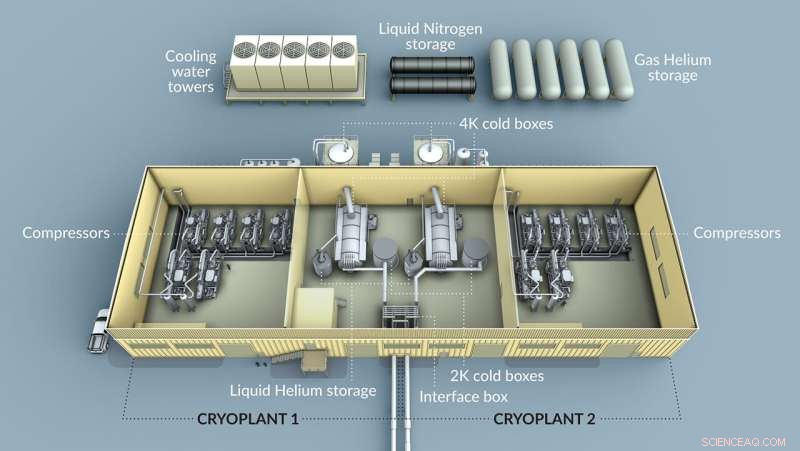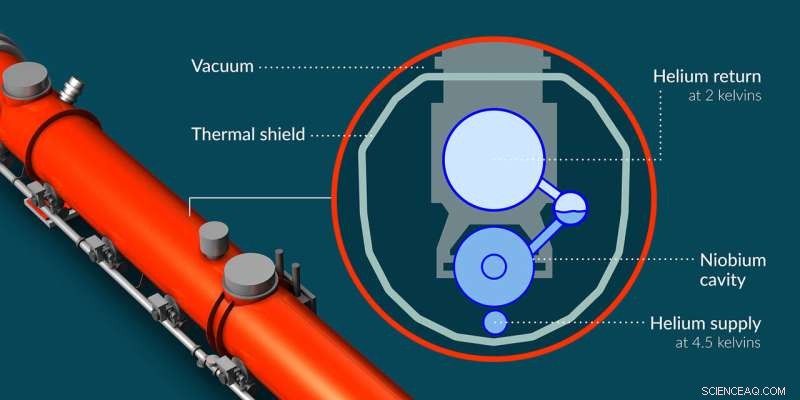
Un schéma de la cryoplante LCLS-II. Crédit :Greg Stewart/Laboratoire national des accélérateurs SLAC
Aujourd'hui, il ne faut qu'une heure et demie pour rendre un accélérateur de particules supraconductrices au SLAC National Accelerator Laboratory du ministère de l'Énergie plus froid que l'espace extra-atmosphérique.
"Maintenant, vous cliquez sur un bouton et la machine passe de 4,5 Kelvin à 2 Kelvin", a déclaré Eric Fauve, directeur de l'équipe cryogénique du SLAC.
Alors que le processus est maintenant entièrement automatisé, amener cet accélérateur, appelé LCLS-II, à 2 Kelvin, ou moins 456 degrés Fahrenheit, a pris six ans de conception, de construction, d'installation et de démarrage d'un système complexe.
Le LCLS original, ou Linac Coherent Light Source, accélère les électrons pour finalement produire des rayons X utilisés dans les expériences de sondage d'atomes et de molécules. LCLS-II fonctionnera en même temps que LCLS. Cependant, contrairement au LCLS, qui utilise des pièces en cuivre à température ambiante pour accélérer les électrons, la mise à niveau LCLS-II utilise des cryomodules supraconducteurs. Ces cryomodules transmettent plus efficacement l'énergie des électrons, ce qui contribuera à générer des impulsions de rayons X plus puissantes pour élargir les possibilités expérimentales dans tous les domaines.
Mais, alors que LCLS peut fonctionner à température ambiante, LCLS-II doit être refroidi à 2 Kelvin, à seulement 4 degrés Fahrenheit au-dessus du zéro absolu, pour devenir supraconducteur.
Et cela signifiait que le SLAC avait besoin d'une équipe pour se concentrer sur les choses froides.
Réunir une équipe pour assembler une cryoplante
Avant le refroidissement du LCLS-II, il n'y avait pas de groupe consacré à la cryogénie au SLAC.
"Notre plus grand défi était que c'était la première fois que nous faisions cela avec une nouvelle équipe", a déclaré Fauve.
L'équipe cryogénique du LCLS-II, aujourd'hui composée de 20 opérateurs et ingénieurs, s'est formée en 2016 au SLAC pour construire l'installation qui refroidit l'accélérateur :une usine cryogénique.
"Il s'agit d'un système compliqué avec de nombreux sous-systèmes qui fonctionnent en tandem", a déclaré Viswanath Ravindranath, ingénieur en chef des procédés cryogéniques pour LCLS-II.
Le SLAC a travaillé en étroite collaboration avec des ingénieurs du Fermi National Accelerator Laboratory et du Jefferson National Accelerator Facility du DOE, ainsi qu'avec des sociétés cryogéniques de premier plan pour concevoir et acquérir des matériaux pour la cryoplante.
"Cette collaboration a permis au projet LCLS-II de bénéficier des meilleures ressources cryogéniques au sein des laboratoires du DOE et ailleurs", a déclaré Fauve.

Une coupe transversale de l'accélérateur LCLS-II montrant où l'hélium liquide et gazeux entre et sort du système. Crédit :Greg Stewart/Laboratoire national des accélérateurs SLAC
La cryoplante est remplie d'hélium, qui est refroidi puis pompé vers le LCLS-II. Alors que tous les autres éléments gèlent en dessous de 4 Kelvin, l'hélium peut rester un fluide, et à 2 Kelvin, l'hélium devient superfluide, ce qui signifie qu'il coule sans viscosité. Ce fait, et la capacité de l'hélium superfluide à mieux conduire la chaleur que toute autre substance connue, en font le réfrigérant idéal pour refroidir un accélérateur supraconducteur.
Avant que le refroidissement ne commence, des remorques remplies de réservoirs en forme de hot-dog livrent de l'hélium gazeux à température ambiante (environ 300 Kelvin) dans les réservoirs de stockage extérieurs de la cryousine. L'usine cryogénique nécessite au total quatre tonnes d'hélium.
Mais cet hélium arrive impur. Toutes les impuretés finiront par geler et obstruer le système. Les purificateurs doivent donc d'abord piéger l'humidité ou les gaz indésirables, tels que l'azote, pour obtenir 99,999 % d'hélium.
Après purification, des compresseurs élèvent la pression de l'hélium. La pression et la température d'un gaz sont couplées :lorsque la pression diminue, la température diminue également. So, while helpful later, this incidentally raises helium's temperature to 370 Kelvin.
Following compression, five large towers containing cooling water are used to lower helium's temperature back down to 300 Kelvin. The gas then enters the cryoplant's 4K cold box, which is a giant, uber-complicated helium refrigerator.
In the cold box, liquid nitrogen running 77 Kelvin knocks the helium down from 300 Kelvin to 80 Kelvin in a heat exchanger. In this device, the warm helium gas and colder liquid nitrogen travel in opposite directions while separated by a thin metal plate, transferring heat through the plate from the helium to the nitrogen. The plant uses 20 metric tons of liquid nitrogen every other day.
The helium then runs through a set of four turboexpanders. Now the initial gas-compressing step pays off:the turboexpanders expand the high-pressure gas, lowering its pressure enough to bring the helium all the way to 5.5 Kelvin.
However, the helium has more expanding to do before it can leave the cold box. It travels through a valve that has lower pressure on the other side. This lower pressure causes the gas to expand, lowering its pressure and bringing its temperature down to 4.5 Kelvin (hence the name of the 4K cold box), where it becomes a liquid.
This liquid helium is then sent through pipes to the accelerator's cryomodules, where it cools the machine to 4.5 Kelvin.
Once the 4K cold box was up and running, it took the Cryogenic team one week to cool LCLS-II from room temperature to 4.5 Kelvin, which it reached for the first time on March 28, 2022. But that's not cold enough!
Colder still
To reach 2 Kelvin, the 4.5 Kelvin helium undergoes yet another (final) expansion through a valve in the accelerator's cryomodules. Again, the lower pressure on the other side of the valve causes helium's pressure to drop. This cools helium to the goal temperature of 2 Kelvin.
Creating the low pressure inside the cryomodule is a feat in itself.
"The magic happens when it goes through that valve, but only because we have a train of cold compressors that maintains the pressure in the cryomodule at very low pressure," Fauve said. This set of five compressors stationed after the valve create the pivotal pressure difference on either side of the valve.
After months of turning on and configuring this cooling system, LCLS-II finally reached 2 Kelvin on April 15.
"Everything was possible because of all the hard work over the years from so many smart and dedicated people," said Swapnil Shrishrimal, cryogenic process and controls engineer for LCLS-II. "Being a small team, as well as a young team, we are very proud of the system we commissioned."
When the electron beam is on and being accelerated by the cryomodules, the 2 Kelvin helium will absorb heat from the accelerator, boil, and turn back into gas. That gas is injected back into the 4K cold box to help cool warmer helium.
"We don't want to waste the cooling capacity, so we try to recover as much of it as possible," Ravindranath said. The system recycles the helium, which is expensive, although essential for long-term operation.
The Cryogenic team actually built two cryoplants, which share a building, but LCLS-II only uses one. The second cryoplant will support planned upgrades to LCLS-II. When both cryoplants are on they will use approximately 10 megawatts of electrical power.
Only four other cryoplants in the United States cool this much helium to 2 Kelvin. Thomas Jefferson National Accelerator Facility and Fermi National Accelerator Laboratory, which both house cryoplants of similar magnitude, supported SLAC's design and procurement of equipment. SLAC collaborated with Oak Ridge National Laboratory, Brookhaven National Laboratory, and CERN as well.
"The years of expertise and support of our partner labs allowed us to do this," Shrishrimal said. Fauve also credits the team's success to their extensive planning and dedication. The entire Cryogenic team stayed on site during the pandemic to continue bringing the plant to life.
"Even when SLAC was shut down, if you were at the cryoplant you would not be able to tell the difference before and during COVID," Fauve said, except for the masks and social distancing, of course.
LCLS-II is expected to produce its first X-rays early next year. The Cryogenic team feels confident they will continue to run their very complicated refrigerator with ease.
"It's a pretty nice and easy operation now because everything is automated," Shrishrimal said. Superconducting X-ray laser reaches operating temperature colder than outer space